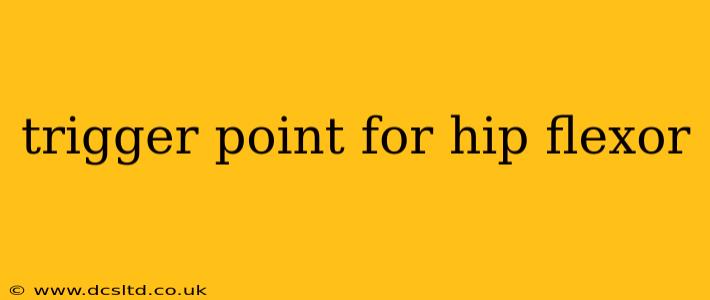The hip flexor muscles are a group of muscles located in the front of your hip, responsible for bending your hip and lifting your knee towards your chest. Experiencing pain in this area? You might be dealing with a hip flexor trigger point. This comprehensive guide will delve into the location, symptoms, and effective treatment options for this common musculoskeletal issue. Understanding your hip flexor trigger points is crucial for managing pain and improving mobility.
What is a Hip Flexor Trigger Point?
A trigger point is a hyperirritable spot within a muscle that, when compressed, causes localized pain and often referred pain elsewhere in the body. In the case of hip flexors, these trigger points can cause significant discomfort, impacting your daily activities and overall well-being. The primary muscles involved are the psoas, iliacus, rectus femoris, and tensor fascia latae. These muscles are frequently overworked, especially in individuals who spend prolonged periods sitting or engaging in repetitive movements.
Where Are Hip Flexor Trigger Points Located?
Pinpointing the exact location of a hip flexor trigger point can be tricky, as the pain can radiate. However, the primary trigger points are generally located deep within the:
- Psoas major: This deep muscle lies in the lower abdomen and connects to the spine and femur. Trigger points here often cause pain in the groin, lower back, and even down the leg.
- Iliacus: Situated in the pelvis, the iliacus works with the psoas to flex the hip. Trigger points can refer pain to the inner thigh and groin.
- Rectus femoris: Part of the quadriceps muscle group, this muscle crosses both the hip and knee joint. Trigger points can cause pain in the front of the hip and thigh, and sometimes down the knee.
- Tensor fascia latae (TFL): Located on the outer hip, trigger points in the TFL can radiate pain to the outer hip, buttock, and even down the outside of the thigh.
What are the Symptoms of Hip Flexor Trigger Points?
The symptoms of hip flexor trigger points vary depending on the affected muscle and the severity of the trigger point. Common symptoms include:
- Pain: Sharp, stabbing, or aching pain in the hip, groin, lower back, thigh, or buttock.
- Stiffness: Restricted range of motion in the hip joint, making it difficult to bend or straighten your leg.
- Weakness: Difficulty lifting your leg or performing activities requiring hip flexion.
- Referred pain: Pain that radiates to other areas, such as the lower back, groin, or knee.
- Muscle spasms: Involuntary contractions of the affected muscle.
- Limited mobility: Difficulty walking, climbing stairs, or performing other activities involving hip movement.
How do I know if my hip pain is from a trigger point?
Differentiating hip pain from trigger points requires a proper diagnosis by a healthcare professional. They will assess your symptoms, range of motion, and palpate the affected muscles to locate potential trigger points. Imaging techniques like X-rays or MRIs might be used to rule out other conditions.
What causes hip flexor trigger points?
Several factors can contribute to the development of hip flexor trigger points. These include:
- Prolonged sitting: Sitting for extended periods shortens and tightens the hip flexors.
- Repetitive movements: Activities involving repetitive hip flexion, such as running or cycling, can overload the muscles.
- Poor posture: Slouching or poor posture puts extra strain on the hip flexors.
- Muscle imbalances: Weakness in other muscle groups can lead to compensatory overuse of the hip flexors.
- Direct trauma: Injuries such as falls or strains can trigger the formation of trigger points.
- Stress and anxiety: Increased muscle tension due to stress can also contribute to trigger points.
How are hip flexor trigger points diagnosed?
Diagnosis typically involves a physical examination by a doctor, physical therapist, or other qualified healthcare professional. They'll assess your symptoms, range of motion, and palpate the hip flexor muscles to identify any tender or taut bands. Imaging tests are generally not needed unless other causes of hip pain are suspected.
How are hip flexor trigger points treated?
Several treatment approaches can effectively address hip flexor trigger points:
- Self-massage: Applying pressure directly to the affected area can help to deactivate the trigger point.
- Stretching: Regularly stretching the hip flexors can improve flexibility and reduce muscle tension.
- Foam rolling: Using a foam roller to massage the hip flexors can help to release tension and improve blood flow.
- Dry needling: A technique involving inserting thin needles into the trigger points to stimulate muscle relaxation. This should only be performed by a qualified professional.
- Physical therapy: A physical therapist can develop a personalized treatment plan to address your specific needs, including exercises, stretches, and manual therapy techniques.
By understanding the location, symptoms, and treatment options for hip flexor trigger points, you can take proactive steps to manage pain and improve your overall well-being. Remember to consult with a healthcare professional for diagnosis and guidance on the best treatment approach for your individual circumstances. Don't hesitate to seek professional help – effective management of these trigger points can significantly improve your quality of life.
